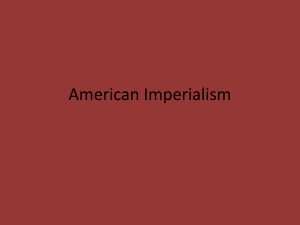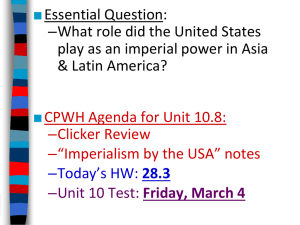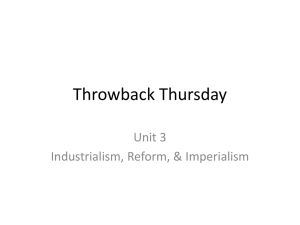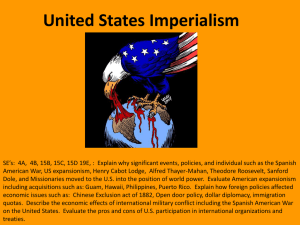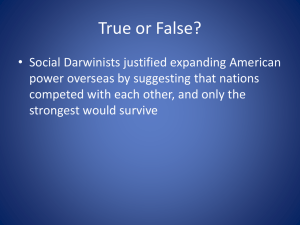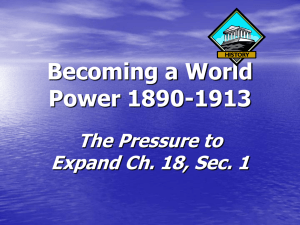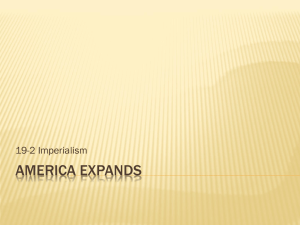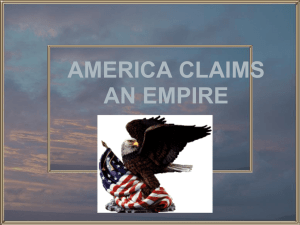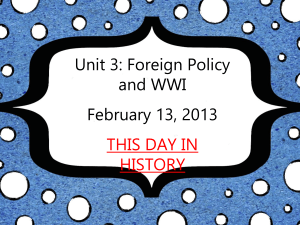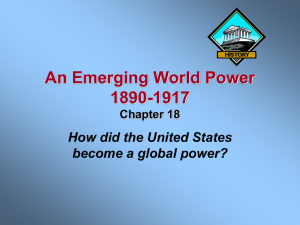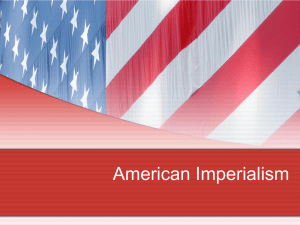Imperialism OGT REVEIW - arlingtonhighschoolhistoryrocks
advertisement
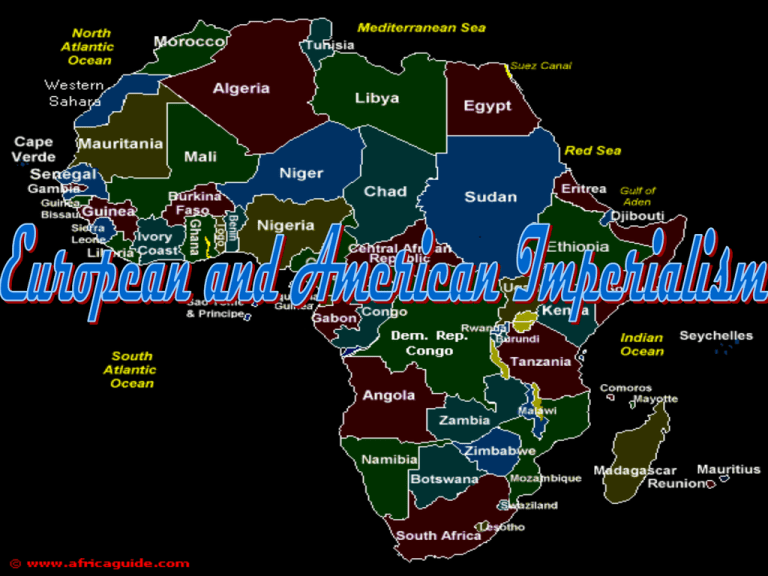
The New Imperialism In the 1800s European nations began a new push ** IMPERIALISM the extension of a nation’s power over other lands for economic and political gain. Essay Explain why Westerners began to increase their search for colonies after 1880 Economic Power Religious *Access to raw materials such as rubber, oil, and tin *Colonial possessions became a symbol of power *Access to new markets to sell goods to in Asia, Africa, and Latin America *Nations raced to gain control of as much territory as possible to demonstrate their strength compared to other nations *Europeans believed that they had a moral responsibility to civilize primitive people The Constantly Changing White House 1880-1900 **Direct Rule officials from the mother country were put in charge of taxes, law and order, and other government business inside the colonial possession -Great Britain and France still used this method in areas of Asia where they had to overthrow a popular government to take control. Concerns and Issues for the Colonizing Countries -Colonial powers did not want their colonies to develop their own industries. -Colonial powers feared giving the native peoples political rights because they might want full participation in government. *The White Man’s Burden European belief that God supported White Supremacy. Thus, they believed they had a moral responsibility to civilize the natives in Africa. -Native people worked on plantations for wages kept at poverty levels. -Colonial governments kept taxes high on the peasants. Imperialism in INDIA Throughout the first half of the 1800s great portions of India were under the control of a British land company called the British East India Company (sort of like in the American colonies In 1860 a Indian rebellion was crushed, and the British government took governing power away from the East India Company. IN 1876 QUEEN VICTORIA of GREAT BRITAIN TOOK THE TITLE OF EMPRESS OF INDIA! BRITISH RULE IN INDIA….Good, Bad, and Ugly NEGATIVE CONSEQUENCES TO BRITISH RULE IN INDIA 1. British manufactured goods destroyed local industries (like Wal-Mart runs local business into bankruptcy 2. The British government charged so much in taxes that Indian peasants were forced to become tenant farmers or give up their land completely. 3. ***The British government also forced many farmers to quit growing crops to produce cotton. THIS LEAD TO A FOOD SHORTAGE IN INDIA THAT CAUSED THRITY MILLION INIANS TO STARVE TO DEATH BY 1900 Getting Hindus and Muslims to Work Together The fighting between the Hindus and the Muslims in India kept the Indian people from getting the British government to grant them more political freedom **Mohandas Gandhi -native born Indian who was educated in England and went to work as a lawyer serving the interests of Indian workers in South Africa. -In 1915 Gandhi returned to India to take over the Nationalist movement and fight for the rights of the Indian people! The Work of Gandhi Gandhi’s Plan of Attack???? 1. NON-VIOLENT RESISTANCE Gandhi encouraged forms of Civil Disobedience….which is protest that breaks laws w/o hurting people in the process. By breaking unjust laws, people can call attention to the abuses being committed by the oppressive government. 2. Boycotts…Gandhi called upon Indian citizens to quite buying into British manufactured goods. Relying on British business for goods only made the people of India more dependent on Great Britain U.S. Imperialism Why Would the U.S. Start to Branch Outside its borders? 1. 2. Imperialism The U.S. saw the money that could be made from establishing colonies. The U.S. government eyed Latin American and Caribbean because of its sugar and fruit plantations. Manifest DestinyThe U.S. believed it was our God given right to extend ourselves outside our own borders and share our practices with others. It All Started in the Pacific **Open Door Policy Signed with China in the 1850s this treaty allowed for free trade between all nations in the Pacific Ocean….this opened China and Japan to trade with the United States. Taking Over hawaii! Hawaii was an island KINGDOM in the Pacific halfway between the United States and Japan. It was the perfect spot for ships to stop and refuel and……………it was a goldmine for American fruit companies In 1891, *Queen Liliuokalani, the last monarch of Hawaii, tried to force Americans evacuate from her kingdom. *In 1893U.S. marines helped a group of Hawaiian planters who were making money from U.S. involvement overthrow the monarchy and set up a new government! The Standoff in Cuba Cuba was a Spanish colony 80 miles off the coast of Florida and the scene of the next American military encounter! A Group of Cuban exiles had been training in the United States of 15 years to re-enter Cuba and seize control away from the Spanish colonial government…in 1895 they got their chance The Cuban exiles took advantage of a economic crisis in Cuba to invade the country and managed to seize control of Eastern Cuba and declare their independence in September, 1895. The Spanish sent its army across the Atlantic to take back the land from the Cuban rebels. President McKinley tries to resist Pressure McKinley did not like war and truly wanted to stay out of the dispute between Spain and the Cubans. BUT…… February 1898…. *President McKinley sent the battleship MAINE to Havana, Cuba to evacuate American business men and their families that were living in Cuba if the fighting got to dangerous Anticipating War…Spain declared war on the U.S. April 24, 1898…..McKinley asked Congress for a declaration of war the next day Twisting the Arm of Spain For Centuries Spain had been a World Power. The United States was proving that it was the true force to be reckoned with! BY JULY 1898…. -U.S. Ground Forces had captured or surrounded most of the major cities in Cuba -U.S. had destroyed the Spanish Navy in the Pacific -U.S. had captured Guam and forts in Puerto Rico under Spanish control At the end of July the Spanish government asked for peace….TREATY OF PARIS (12/10/1898) 1. Cuba gains independence Rico and Guam 2. U.S. Pays $20 mil for Philippines 3. U.S. annexes Puerto Teddy Roosevelt’s TOUGH Foreign Policy Big Problems in ColumbiaThe U.S. was doing so much business in the Pacific Ocean it became necessary to find easy access from the Atlantic to the Pacific Ocean. Building a canal became the popular proposal and COLUMBIA controlled the best spot to build the canal…the Isthmus of Panama OPPORTUNITY Panama was a colony of the Columbian government and the people of Panama were waging a revolution against Columbia to gain their independence. Roosevelt ignored Columbia’s right to control their own land and sent navy warships to Panama to prevent Columbia from sending troops in to put down the revolt. The revolt was successful and Panama declared its independence in 1903 Roosevelt Places His Finger on Latin America The New Panamanian government gave the U.S. rights to a 10 mile strip of land called the Canal Zone. Here the U.S. build the Panama Canal which connected the Atlantic to the Pacific Ocean -Roosevelt’s decision to aid the revolution against Columbia was criticized throughout the world. (A Imperialist Tyrant!) -In 1999 the U.S. government turned full control over the canal zone to the Panamanian government. Roosevelt Talks Tough and Backs it Up Roosevelt Made Two Very Strong Stances to Put European Nations in their Place and Clean up the Economic Messes of our Neighbors to the South! *Big Stick Diplomacy Stated that the U.S. would remain the dominant force in the Western Hemisphere and anyone who interfered with our interests in the west would be met with military force! *Roosevelt Corollary An amendment to the Monroe Doctrine, the corollary stated that the U.S. WOULD ACT AS A POLICEMAN IN LATIN AMERICA. THE U.S. WOULD INTERVENE IN LATIN AMERICAN AFFAIRS WHEN THEY BELIEVED IT WAS NECESSARY TO MAINTAIN STABILITY IN THE REGION. From 1908-1922 the U.S. set up new governments in Nicaragua, Haiti, Dominican Republic, Cuba, and the Virgin Islands Imperialism Lets look at a couple samples of how questions look on the OGT that will test your knowledge of European and American imperialism During the Spanish-American War, the U.S. Navy destroyed the Spanish fleet in Manila Bay in the Philippines. The U.S. Congress later voted for annexation of the Philippines. What was one reason for this act of U.S. imperialism? A. to provide the U.S. with a valuable naval base in the Pacific B. to provide the U.S. with a place to relocate its immigrant population C. to decrease the U.S. need to export raw materials for industrialization D. to increase the U.S. population by extending citizenship to the Filipinos Imperialism Lets look at a couple samples of how questions look on the OGT that will test your knowledge of European and American imperialism During the late 19th and early 20th centuries, U.S. foreign policy was closely tied to domestic economic concerns. The annexation of Hawaii, the Open Door Policy with China, and the construction of the Panama Canal in Latin America were all motivated by an interest in A. breaking up monopolies and trusts. B. extending land grants for railroad construction. C. acquiring new markets and sources of raw materials. D. limiting the power of labor unions to strike. Imperialism Lets look at a couple samples of how questions look on the OGT that will test your knowledge of European and American imperialism In the 19th century, European countries claimed that the conquest of Africa would bring the benefits of Western civilization to that continent. From the perspective of African peoples, the effect was A. loss of political independence. B. fewer agricultural products for foreign trade. C. new national boundaries based on ethnic and cultural similarities. D. global appreciation for African cultures and encouragement of their development. Forms of Government Lets look at a couple samples of how questions look on the OGT that will test your knowledge of forms of Imperialism. The following is an example of a 2 point writing question on the OGT. The United States fulfilled one of its imperialist ambitions in the early 20th century by acquiring land to build the Panama Canal. State two reasons (political and/or economic) why U. S. imperialists wanted to build the canal. Write your answer in the Answer Document. (2 points) POTENTIAL WRITTEN RESPONSE . A canal at the Isthmus of Panama would reduce U.S. shipping costs and avoid the necessity of maintaining separate navies in the Atlantic and Pacific. • would achieve world power status • would facilitate U.S. trade with Asia • would ensure control of trade routes across the Atlantic from Europe to Asia • would shorten shipping times between coasts (variant on shipping costs) • would facilitate the movement of naval vessels to different areas of need

